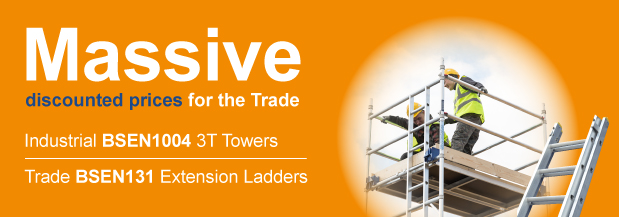Working at height can be a challenging task that requires utmost caution and safety measures. In the United Kingdom, scaffold towers have emerged as a go-to solution for various industries, thanks to their numerous advantages and versatility. Whether it’s for construction projects, maintenance work, or even DIY tasks, scaffold towers have proven to be the best choice for working at height. In this article, we will explore the reasons why scaffold towers are considered the top option in the UK market, delving into their understanding, safety features, efficiency, cost-effectiveness, and environmental impact.
Understanding Scaffold Towers
Before diving deep into the benefits of scaffold towers, it’s crucial to comprehend their basic components and the different types available. Scaffold towers consist of various elements that work together to provide a secure platform for working at height. The basic components include the main frame, platforms, guardrails, and stabilisers.
Basic Components of Scaffold Towers
The main frame acts as the primary structure of the scaffold tower, providing support and stability. It is typically made of high-quality steel or aluminium, ensuring durability and strength. The main frame is designed with precision, taking into account factors such as weight capacity and load distribution. This ensures that the scaffold tower can safely accommodate workers and their equipment.
Platforms, usually made of non-slip materials, offer a safe surface for workers to stand or move around. These platforms are carefully designed to be spacious enough to allow for easy movement and positioning of tools and equipment. The non-slip materials used on the platforms provide additional safety, reducing the risk of accidents caused by slipping or tripping.
Guardrails surround the platforms, preventing accidental falls. These guardrails are strategically placed at appropriate heights to provide a protective barrier for workers. They are made of sturdy materials, capable of withstanding considerable force. The guardrails are designed to be easily installed and removed, allowing for quick access to the platforms while maintaining safety.
Stabilisers, such as outriggers or adjustable legs, enhance the tower’s stability and balance. These components are crucial for ensuring that the scaffold tower remains steady even on uneven surfaces. Outriggers are extended horizontally from the base of the tower, providing additional support and preventing tipping. Adjustable legs allow for fine-tuning the height and levelness of the scaffold tower, ensuring optimal stability.
Different Types of Scaffold Towers
Scaffold towers come in various types, designed to suit different requirements and environments. Each type caters to specific needs, ensuring flexibility and adaptability for diverse working conditions.
Mobile scaffold towers are highly versatile and easy to move around. They are equipped with wheels or casters, allowing for convenient transportation from one location to another. These towers are ideal for projects that require frequent repositioning, such as construction sites or maintenance work in large facilities.
Folding scaffold towers are designed for compact storage and easy assembly. They feature a folding mechanism that allows the tower to be collapsed into a more manageable size. This makes them ideal for situations where storage space is limited or when the tower needs to be transported in a smaller vehicle.
Narrow-span scaffold towers are specifically designed for working in tight or confined spaces. These towers have a narrower width compared to standard scaffold towers, allowing them to fit through doorways or maneuver in narrow corridors. They are commonly used in industries such as shipbuilding, where space constraints are a significant consideration.
By understanding the different types of scaffold towers and their basic components, you can make informed decisions when choosing the right tower for your specific needs. Whether you require mobility, compact storage, or the ability to work in tight spaces, there is a scaffold tower available to meet your requirements.
Safety Features of Scaffold Towers
When it comes to working at height, safety is of paramount importance. Scaffold towers are renowned for their robust safety features, ensuring the well-being of the workers and compliance with UK safety regulations.
Working at height can be risky, but scaffold towers are designed to mitigate these risks and provide a secure working environment. Let’s explore some of the key safety features that make scaffold towers a reliable choice.
Stability and Balance in Scaffold Towers
Scaffold towers are engineered to provide exceptional stability and balance, minimising the risks of accidents or collapses. The use of stabilisers, such as outriggers or adjustable legs, enhances the tower’s stability on uneven terrains or when exposed to external forces.
Furthermore, scaffold towers are equipped with a strong and durable main frame, ensuring the tower remains steady even during heavy workloads. The materials used in their construction, such as high-quality steel or aluminium, contribute to their stability and structural integrity.
These stability features not only protect the workers but also prevent damage to the surrounding structures, ensuring a safe and efficient work environment.
Safety Regulations for Scaffold Towers in the UK
The UK has stringent safety regulations in place to protect workers involved in working at height. Scaffold towers are designed and manufactured to comply with these regulations, ensuring safe working conditions.
One of the key safety regulations is the weight capacity limit. Scaffold towers are designed to support a specific maximum weight, and exceeding this limit can compromise the tower’s stability and pose a significant risk to the workers. By adhering to weight capacity limits, scaffold towers ensure that workers can perform their tasks without worrying about structural failures.
Another important safety regulation is the mandatory guardrail height. Scaffold towers are equipped with guardrails at specific heights to prevent falls and provide a secure working platform. These guardrails are designed to withstand considerable force and are positioned strategically to offer maximum protection to the workers.
In addition to weight capacity limits and guardrail heights, scaffold towers also adhere to regulations regarding platform dimensions, ladder access, and stability in adverse weather conditions. These regulations are in place to ensure the safety and well-being of workers, reducing the risk of accidents and injuries.
Overall, scaffold towers are designed with the utmost consideration for safety. Their stability features and compliance with UK safety regulations make them a reliable choice for working at height. By providing a secure working environment, scaffold towers enable workers to focus on their tasks with peace of mind, knowing that their safety is prioritised.
Efficiency and Productivity with Scaffold Towers
In addition to safety, scaffold towers offer significant efficiency and productivity benefits, allowing workers to complete tasks in a timely and effective manner.
When it comes to construction projects, time is of the essence. Every minute saved can make a difference in meeting deadlines and delivering projects on time. Scaffold towers play a crucial role in saving time and increasing productivity on the job site.
Time-saving Aspects of Using Scaffold Towers
Scaffold towers eliminate the need for time-consuming setups or dismantling processes commonly associated with traditional scaffolding systems. Their modular design enables quick assembly and disassembly, saving valuable time on the job site.
Imagine a construction site where workers no longer have to spend hours setting up scaffolding or taking it down at the end of the day. With scaffold towers, this time-consuming process becomes a thing of the past. Workers can focus on their tasks and get the job done efficiently.
Moreover, the ease of relocation enhances productivity by enabling workers to swiftly move the scaffold tower as the project progresses. In a dynamic construction environment, where different areas of the site require attention at different times, the ability to relocate the scaffold tower quickly is invaluable.
Whether it’s moving from one side of the building to another or adjusting the height of the tower, scaffold towers provide the flexibility needed to keep up with the ever-changing demands of a construction project.
Enhancing Work Efficiency with Scaffold Towers
Scaffold towers provide workers with a stable and secure platform, allowing them to carry out tasks efficiently. The presence of guardrails ensures worker safety while reducing the fear of falls, thereby enabling workers to focus solely on their work.
When workers feel safe and confident in their working environment, they can concentrate on their tasks without distractions or concerns about their well-being. Scaffold towers provide this peace of mind, allowing workers to give their full attention to the job at hand.
The platforms’ spaciousness allows for better manoeuvrability and organisation of tools and equipment, contributing to improved workflow and overall efficiency. With ample space to move around, workers can easily access their tools and materials, eliminating the need for time-consuming searches or interruptions.
Furthermore, the organised layout of tools and equipment on the scaffold tower platform minimises the risk of accidents or delays caused by misplaced items. Every tool has its designated spot, ensuring that workers can quickly locate and retrieve what they need, further streamlining their workflow.
Cost-effectiveness of Scaffold Towers
When it comes to investing in work-at-height solutions, cost-effectiveness is a crucial consideration. Scaffold towers not only provide numerous benefits but also offer long-term savings and value for money.
Initial Investment and Long-term Savings
While the initial investment in scaffold towers might be higher than other alternatives, their durability and adaptability result in long-term savings. Scaffold towers are built to withstand harsh weather conditions and heavy workloads, ensuring they remain functional for extended periods. Additionally, their reusable nature eliminates the need for frequent replacements, thereby reducing costs in the long run.
Maintenance and Durability of Scaffold Towers
Scaffold towers undergo rigorous testing and adhere to quality standards, making them highly durable and low maintenance. Regular inspections and minimal upkeep requirements contribute to reduced maintenance costs while ensuring the towers’ longevity. Moreover, their versatility allows them to be used across various projects, further maximising their value for money.
Environmental Impact of Scaffold Towers
With increasing global concern for the environment, it’s essential to consider the impact of work-at-height solutions on sustainability and urban development.
Sustainability Factors of Using Scaffold Towers
Scaffold towers are manufactured using sustainable materials that prioritise eco-friendliness without compromising on strength and quality. Furthermore, their reusable nature significantly reduces waste generation associated with traditional scaffolding systems. By opting for scaffold towers, companies can actively contribute to sustainable practices while prioritising worker safety.
Scaffold Towers and Urban Development
As urban landscapes continue to evolve, scaffold towers play a vital role in construction and maintenance projects. Their adaptability and versatility ensure that work can be efficiently carried out, even in challenging urban environments. Scaffold towers minimise disruption to the surrounding areas while enabling the completion of essential tasks, promoting steady urban development.
Conclusion
In conclusion, scaffold towers have rightfully earned their reputation as the best option for working at height in the United Kingdom. Their understanding, safety features, efficiency, cost-effectiveness, and positive environmental impact make them a preferred choice across various industries. With the emphasis on worker safety, efficiency, and sustainability, scaffold towers prove to be an indispensable tool for any project requiring work at height in the UK.


